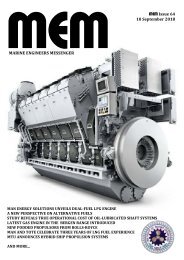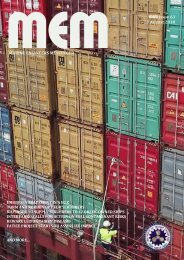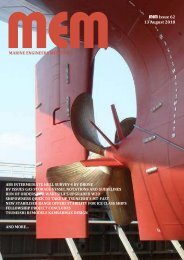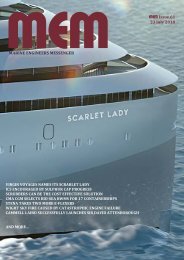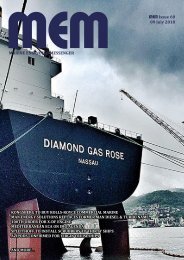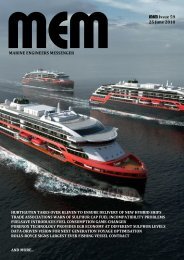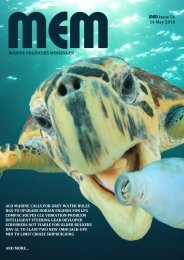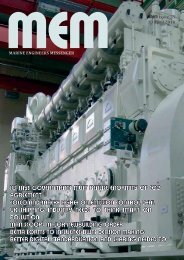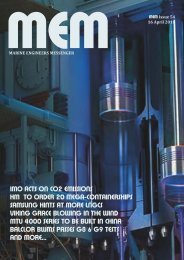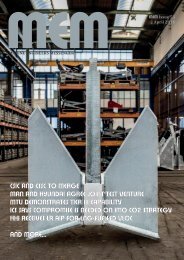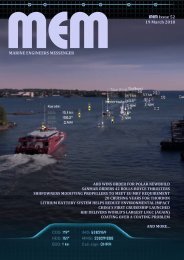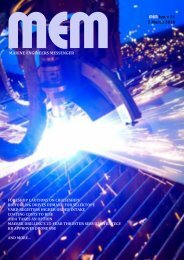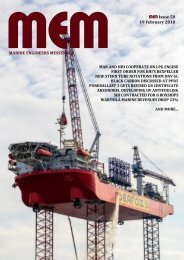MEM57
Marine Engineers Messenger, Volume 3 Issue 57.
Marine Engineers Messenger, Volume 3 Issue 57.
You also want an ePaper? Increase the reach of your titles
YUMPU automatically turns print PDFs into web optimized ePapers that Google loves.
MEM<br />
MEM<br />
MARINE ENGINEERS MESSENGER<br />
Issue 57<br />
28 May 2018<br />
ICS SAYS ZERO CARBON FUELS NEEDED TO MEET TARGETS FOR SHIPPING<br />
ICS PREDICTS "SULPHUR CAP CHAOS"<br />
LR TOOL EVALUATES BEST 2020 SULPHUR OPTIONS<br />
SSI CLAIM BIOFUELS WILL MEET SUPLHUR CHALLENGE<br />
ROLLS-ROYCE AND FINFERRIES TO OPTIMISE SHIP EFFICIENCY<br />
ISPS NEEDS UPDATING TO ACCOUNT FOR DRONE ATTACK<br />
AND MORE...
MEM<br />
MARINE ENGINEERS MESSENGER<br />
Telegraph<br />
The Lloyd’s Register report commissioned by the Sustainable<br />
Shipping Initiative on the merits of using biofuels to meet the<br />
impending global sulphur cap rule is way of mark and will do more<br />
environmental harm than good if the shipping industry goes down<br />
the vegetable oil route.<br />
While some biofuels are obviously a good way of reducing<br />
shipping’s environmental footprint, the use of vegetable oils has a<br />
greater impact on the environment than burning fossil fuels.<br />
Not so long ago, there was considerable investment in processing<br />
the Jatropha plant, which was then considered the ultimate green<br />
fuel. It came to pass however that producing the stuff did more harm<br />
than good. The plant is highly toxic, and lush fertile ground was<br />
razed to make a way for Jatropha planting.<br />
The same can be said of palm and corn-based biofuels, which have<br />
proven controversial given the consequent increase in deforestation,<br />
drainage of peatlands, loss of biodiversity and reduced availability of<br />
freshwater. Palm and corn plantations for fuel have also seen an<br />
increase in the use of chemical-based fertilisers and pesticides.<br />
Indeed, the Royal Academy of Engineering published a report last<br />
year stating that burning some vegetable-based biofuels have led to<br />
more emissions than burning fossil fuels. The report, Sustainability<br />
of Liquid Biofuels, advocated greater use of waste products, such as<br />
used cooking oils, ‘fatbergs’, and timber.<br />
Another interesting report by the Hunger Math blog highlighted<br />
the impact on global food production when land that could be used<br />
for food crops is given over to crops for fuel. Have a read of this very<br />
thought proving report here:<br />
https://hungermath.wordpress.com/2015/10/29/how-muchfarmland-is-used-for-biofuel/<br />
While it is commendable that there is a movement to create a<br />
more sustainable shipping industry, the bigger picture has to be<br />
taken into account.<br />
MEM Contacts:<br />
MEM Issue 57<br />
28 May 2018<br />
Editorial:<br />
Bill Thomson<br />
editorial@mem-online.com<br />
+44 (0) 208 339 6185<br />
+44 (0)777 7668 928<br />
Advertising/Subscriptions:<br />
advertising@mem-online.com<br />
0208 339 6183<br />
Publisher:<br />
publisher@mem-online.com<br />
Website:<br />
www.mem-online.com<br />
The information published in MEM does<br />
not necessarily represent the views of<br />
the publisher. The publisher makes no<br />
representation or warranty as to the<br />
accuracy or correctness of the<br />
information or accepts responsibility<br />
for any loss, damage or other liability<br />
pertaining to the information published<br />
in this newsletter.<br />
©2018 Seaborne Communications Ltd<br />
ADVERTISE HERE AND REACH OUT TO AN MEM COMMUNITY OF<br />
MORE THAN 8000 MARINE ENGINEERING PROFESSIONALS<br />
For more information about our cost-effective advertising rates<br />
Email: advertising@mem-online.com or visit www.mem-online.com<br />
3
EMISSIONS<br />
ICS SAYS ZERO CARBON FUELS NEEDED TO MEET TARGETS FOR SHIPPING<br />
The ambitious CO2 reduction targets<br />
set by IMO for the year 2050 can<br />
only be delivered with the global<br />
rollout of zero CO2 fuels and<br />
propulsion systems, says the<br />
International Chamber of Shipping<br />
(ICS).<br />
Speaking at the annual Summit of<br />
Transport Ministers hosted by the<br />
OECD International Transport<br />
Forum in Leipzig, ICS Deputy<br />
Secretary General, Simon Bennett<br />
said: “As well as being consistent<br />
with the 1.5 degree climate change<br />
goal, the IMO targets are far more<br />
ambitious than what has so far been<br />
agreed for aviation, or indeed the<br />
commitments made by governments<br />
with respect to the rest of the global<br />
economy under the Paris<br />
Agreement. But the shipping<br />
industry greatly welcomes the IMO<br />
agreement because it gives us the<br />
signal we need to get on with the job<br />
of decarbonizing the sector<br />
completely as soon as possible.”<br />
With respect to the IMO goals set<br />
for 2050 – a 70% efficiency<br />
improvement as an average across<br />
the fleet, and a total CO2 cut by the<br />
sector of at least 50% by 2050<br />
(regardless of expected growth in<br />
maritime trade), Mr Bennett said<br />
“these targets can realistically only<br />
be achieved with the development<br />
and global roll out of genuine zero<br />
CO2 fuels.<br />
“To be clear, zero CO2 fuels<br />
means radical and as yet unproven<br />
technologies such as hydrogen fuel<br />
cells using ammonia or methanol or<br />
batteries powered using renewable<br />
energy. While LNG or biofuels will<br />
play an important part in the<br />
transition we only really see these<br />
as interim solutions that won’t<br />
deliver the ambitious targets which<br />
IMO has now set for 2050.<br />
“While we are confident new<br />
zero CO2 technologies will<br />
eventually deliver they are not yet<br />
fully ready for maritime<br />
application, and certainly not yet<br />
for deep sea trades.”<br />
Bennett added: “The<br />
development of these new<br />
technologies will require cooperation<br />
between all relevant<br />
stakeholders particularly<br />
shipbuilders, engine manufacturers<br />
and classification societies, which<br />
are the repositories of the<br />
industry’s technical knowledge.<br />
But when it comes to pure<br />
research into new propulsion<br />
systems this has to be facilitated by<br />
governments within a framework<br />
that needs to be developed by the<br />
UN IMO.”<br />
“To kick start new technologies<br />
we also may need to make some<br />
compromises. For example, in<br />
order to develop hydrogen<br />
propulsion systems, and gain<br />
experience of the serious technical<br />
challenges, we may need to initially<br />
permit use of hydrogen that is still<br />
derived from fossil feedstock rather<br />
than renewables, a technology<br />
which is not quite there yet, though<br />
probably not insurmountable in the<br />
longer term.”<br />
With regard to short term<br />
measures, Bennett said<br />
the industry recognises that there<br />
is a political need among many<br />
governments for new IMO<br />
regulations that will start achieving<br />
further CO2 reductions from the<br />
sector before 2023, so that the<br />
industry stays on track to improve<br />
efficiency, as an average across the<br />
sector, by at least 40% by 2030, as<br />
also agreed by IMO.<br />
The next round of IMO<br />
discussions will take place in<br />
October 2018 in order to consider a<br />
list of possible candidate measures<br />
for CO2 reduction, and the industry<br />
is planning to make some detailed<br />
submissions to that meeting.<br />
“We are particularly focused on<br />
further improvements to the<br />
Energy Efficiency Design Index<br />
(EEDI) for new ships which already<br />
requires a 30% efficiency<br />
improvement for ships built in<br />
2025 compared to 2013, perhaps<br />
moving forward the<br />
implementation dates that<br />
currently apply for certain ship<br />
types such as containerships,”<br />
explained Bennett.<br />
Headded “At the moment we<br />
believe the IMO strategy can best<br />
be delivered with technical<br />
measures alone. We don’t think we<br />
need the smoke and mirrors of<br />
market based measures or the<br />
purchase of carbon offsets to<br />
compensate for emissions which<br />
the sector is quite capable of<br />
reducing itself in line with the<br />
targets now agreed by IMO.<br />
ICS has produced a briefing note<br />
on possible zero CO2 marine fuels<br />
which can be seen here.<br />
4
ICS PREDICTS "SULPHUR CAP CHAOS" AND URGES EU TO FOLLOW IMO STRATEGY<br />
The International Chamber of<br />
Shipping (ICS) fears “chaos and<br />
confusion” unless the IMO urgently<br />
resolves some serious issues<br />
concerning the implementation of<br />
the 0.5% sulphur in marine fuel<br />
cap, scheduled to come into effect<br />
globally overnight on 1 January<br />
2020.<br />
This was the principal<br />
conclusion of the Annual General<br />
Meeting of ICS’s member national<br />
shipowner associations which met<br />
in Hong Kong last week.<br />
ICS Chairman Esben Poulsson,<br />
who was re-elected at the AGM for<br />
a further term, said: “The shipping<br />
industry fully supports the IMO<br />
global sulphur cap and the positive<br />
environmental benefits it will<br />
bring, and is ready to accept the<br />
significant increase in fuel costs<br />
that will result. But unless a<br />
number of serious issues are<br />
satisfactorily addressed by<br />
governments within the next few<br />
months, the smooth flow of<br />
maritime trade could be<br />
dangerously impeded. It is still far<br />
from certain that sufficient<br />
quantities of compliant fuels will<br />
be available in every port<br />
worldwide by 1 January 2020. And<br />
in the absence of global standards<br />
for many of the new blended fuels<br />
that oil refiners have promised,<br />
there are some potentially serious<br />
safety issues due to the use of<br />
incompatible bunkers.”<br />
Poulsson added: “Governments,<br />
oil refiners and charterers of ships<br />
responsible for meeting the cost of<br />
bunkers all need to understand<br />
that ships will need to start<br />
purchasing compliant fuels several<br />
months in advance of 1 January<br />
2020. But at the moment no one<br />
knows what types of fuel will be<br />
available or at what price,<br />
specification or in what quantity.<br />
Unless everyone gets to grips with<br />
this quickly we could be faced with<br />
an unholy mess with ships and<br />
cargo being stuck in port.”<br />
ICS emphasises that<br />
governments will need to make<br />
significant progress on these<br />
issues at a critical IMO meeting in<br />
July about the impending global<br />
sulphur cap, to which ICS – in<br />
cooperation with other<br />
international industry associations<br />
– will be making a number of<br />
detailed technical submissions to<br />
assist successful implementation<br />
of what ICS describes as a<br />
regulatory game changer.<br />
The ICS AGM endorsed its<br />
support for the historic UN IMO<br />
agreement adopted in April 2018<br />
on a comprehensive strategy to<br />
phase out international shipping’s<br />
CO2 emissions. This includes<br />
targets to improve the sector’s<br />
CO2 efficiency by at least 40% by<br />
2030 and 70% by 2050, and a very<br />
ambitious goal to cut the sector’s<br />
total GHG emissions by at least<br />
50% by 2050 regardless of growth<br />
in demand for maritime transport.<br />
ICS member national<br />
associations agreed to contribute<br />
constructively to the immediate<br />
development of additional IMO<br />
regulations that will start to have a<br />
direct impact on further reducing<br />
international shipping’s CO2<br />
emissions before 2023, in line with<br />
the new IMO strategy. They<br />
agreed that ICS should come<br />
forward with detailed proposals<br />
before the next round of IMO<br />
discussions in October on reducing<br />
GHG emissions from shipping.<br />
However, ICS members<br />
expressed serious disappointment<br />
at the apparent intention of the<br />
European Union to press on with<br />
the implementation of a regional<br />
CO2 reporting system at variance<br />
to the global system already<br />
agreed by IMO, despite having<br />
given an undertaking to align the<br />
MRV regulation with the global<br />
regime.<br />
“We are still waiting to see the<br />
final recommendations from the<br />
European Commission following a<br />
recent consultation’ said Poulsson.<br />
“But the industry has made clear<br />
its total opposition to the<br />
publication of data about<br />
individual ships using abstract<br />
operational efficiency metrics that<br />
bear no relation to CO2 emissions<br />
in real life and which will be used<br />
to penalise shipowners unfairly.<br />
“Anything less than a full<br />
alignment with the IMO CO2 data<br />
collection system will be seen as a<br />
sign of bad faith by many non-EU<br />
nations who recently agreed to the<br />
IMO GHG reduction strategy,<br />
precisely to discourage such<br />
unilateral measures which risk<br />
seriously distorting maritime<br />
trade and global shipping<br />
markets.”<br />
5
SONGA TO SCRUB 14 SHIPS WITH CROE SYSTEM<br />
CR Ocean Engineering (CROE) has been awarded a<br />
contract to retrofit its exhaust gas cleaning system to<br />
14 vessels managed by Songa Shipmanagement, a<br />
division of the Oslo-based BLYSTAD Group. There is an<br />
option to retrofit an additional five vessels.<br />
The CR Ocean Engineering Marine Scrubbers will<br />
be installed on the shipmanager’s oil/chemical tankers<br />
and heavy lift vessels from summer 2018 through to<br />
early 2020.<br />
“We are proud to be working with Songa,” said Nick<br />
Confuorto, CROE President and COO. “They have<br />
proven to be an excellent company to work with and<br />
it’s an honour for us to help them face this major<br />
emissions challenge.”<br />
In addition to the existing 0.1% Sulphur fuel<br />
Emission Control Areas (ECAs) in Europe and North<br />
America, in January 2020 ship’s operating throughout<br />
the world will need to reduce the sulphur content of<br />
the fuel burned to 0.5% S from the current 3.5%.<br />
According to Songa Shipmanagement Managing<br />
Director, Kenneth MacLeod: “We meet our corporate<br />
responsibility knowing that a cleaner environment is<br />
good for the planet. And that’s everyone’s business.”<br />
Allied Shipbroking called Marine Scrubbing<br />
technology, the “fastest and cheapest”way to reduce<br />
harmful diesel fuel emissions to meet the stringent<br />
International Maritime Association (IMO) compliance<br />
requirements for the shipping industry scheduled to<br />
go into effect in 2020.<br />
Based on over 60 years of experience in air<br />
pollution control, US-based CROE developed a<br />
compact scrubbing system for ship application. The<br />
company has three basic designs: Open Loop, Closed<br />
Loop, and Hybrid, all of which can be fitted as a single<br />
stream or multi-stream system.<br />
LR TOOL EVALUATES BEST 2020 SULPHUR OPTIONS<br />
Lloyd’s Register has introduced an<br />
online tool to help ship operators<br />
understand the best options<br />
available for meeting the global<br />
sulphur in fuel oil limit to enter<br />
into force in 2020.<br />
The classification society says<br />
its Sulphur 2020 – Options<br />
Evaluator can bring clarity to what<br />
the potential cost and investment<br />
implications could be for the<br />
various compliance strategies,<br />
such as transition from fuel oil to<br />
MGO, use of scrubbers and HSFO<br />
or use of other compliant fuels<br />
such as LNG or Methanol.<br />
The Options Evaluator allows<br />
ship operators to compare<br />
different compliance strategies by<br />
reviewing emissions output and<br />
comparing the different CAPEX<br />
and OPEX implications of each<br />
option.<br />
LR’s Douglas Raitt, Regional<br />
Consultancy Manager Asia,<br />
commented: “2020 is around the<br />
corner and to date it appears most<br />
operators will transition from fuel<br />
oil to gas oil operations to meet<br />
the global sulphur in fuel oil limit.<br />
Scrubber uptake or LNG and<br />
Methanol as a marine fuel are<br />
slowly evolving, perhaps as a<br />
function of a ‘wait and see’<br />
approach by the shipping industry.<br />
We developed the options<br />
evaluator to give some guidance to<br />
operators who have not yet fully<br />
considered their options for 2020<br />
compliance.”<br />
Justin Murphy, CEO<br />
International Bunker Industry<br />
Association, said: “IBIA is fully<br />
involved at IMO on all matters<br />
marine fuel related and for years<br />
has been the voice of the industry<br />
pushing for practical regulations<br />
whichever options industry<br />
players choose. This options<br />
evaluator tool, one of a number<br />
being developed, is an aid that may<br />
complement owners’ and<br />
operators’ future efforts to<br />
develop a compliance strategy.”<br />
The tool can be accessed here<br />
MARINE ENGINEERS MESSENGER<br />
SHIP TECHNOLOGY NEWS TO 8544 DECISION MAKERS<br />
EVERY TWO WEEKS<br />
Click here for more information about our favourable advertising rates or<br />
email: advertising@mem-online.com<br />
6
LNG FUEL<br />
AET OPTS FOR LNG FOR<br />
NEW TANKERS<br />
The market acceptance of liquefied<br />
natural gas (LNG) as ship fuel<br />
appears to be strengthening<br />
following the recent orders for<br />
Wärtsilä’s W34 dual fuel engine and<br />
associated LNG fuelling system.<br />
Two new shuttle tankers under<br />
construction at Samsung Heavy<br />
Industries for Singapore-based AET<br />
Tankers will be installed with the<br />
auxiliary engines along with the<br />
company’s LNGPac fuel system,<br />
pictured. The contract marks the<br />
100th LNGPac unit Wärtsilä has sold<br />
since market introduction in 2009.<br />
The LNGPac system comprises a<br />
bunkering station, the LNG fuel tank<br />
and related process equipment, as<br />
well as the control and monitoring<br />
system.<br />
“A major reason for the global<br />
acceptance of LNG fuel for shipping<br />
is that Wärtsilä realised at an early<br />
stage that more than just a dual-fuel<br />
engine and a stand-alone LNG<br />
system was needed. LNG fuelled<br />
ships require a complete fuel<br />
handling system, and the innovative<br />
LNGPac system very successfully<br />
meets this requirement,” said<br />
Mathias Jansson, General Manager,<br />
Fuel Gas Supply Systems, Wärtsilä<br />
Marine Solutions.<br />
The first LNGPac installation was<br />
for the chemical tanker Bit<br />
Viking operated by Sweden’s Tarbit.<br />
This vessel was converted for LNG<br />
fuel operation in 2011. To date,<br />
LNGPac has been installed across the<br />
range of ship types, including<br />
passenger ferries, tugs, dredgers and<br />
offshore vessels.<br />
Wärtsilä has also been contracted<br />
to supply the 125,000dwt vessels<br />
with its Volatile Organic Compounds<br />
(VOC) recovery technology. This<br />
mixes the VOC with the LNG to<br />
increase fuel efficiency and reduce<br />
CO2 emissions.<br />
Wärtsilä’s full scope of supply for<br />
these ships includes the VOC<br />
recovery plant, the liquefied VOC<br />
fuel tank, the fuel mixing unit,<br />
the LNG fuel tank and fuel supply<br />
system (LNGPac), the gas valve unit<br />
and two Wärtsilä 34DF dual-fuel<br />
auxiliary engines.<br />
MAN TO SUPPLY FULL LNG PROPULSION SYSTEM FOR<br />
FISHING TRAWLER<br />
MAN Diesel & Turbo has been selected to provide a complete propulsion<br />
package and fuel-gas system for the first fishing vessel with LNG propulsion.<br />
An 86m newbuilding purse-seiner, the Libas will be built by Cemre<br />
Shipyard in Istanbul. It will feature a MAN 6L51/60DF main engine, Renk<br />
gearbox, MAN Alpha propeller system and MAN Cryo LNG fuel-gas system<br />
with a 350m³ tank. Liegruppen, the Norwegian fishing group, has ordered<br />
the vessel, while compatriot, Salt Ship Design, has provided the design.<br />
Wayne Jones, Chief Sales Officer with MAN Diesel & Turbo, said: “This is<br />
a pioneering project. At MAN we are convinced that low-emission gas fuels<br />
are the silver bullet to decarbonising the shipping industry and we have<br />
made it our mission to guide our customers through that transition.”<br />
Lex Nijsen, Head of Four-Stroke Marine, MAN Diesel & Turbo: “This is a<br />
very noteworthy win. Our ability to provide this efficient, low-emission,<br />
proven LNG-fuelled propulsion package – a world’s first for this<br />
environmentally sensitive segment – really puts our credentials as a system<br />
provider on display.”<br />
The delivery of the new LNG-propulsion package is part of MAN’s wide<br />
ranging engagement for the establishment of LNG as a shipping fuel. Calling<br />
for a ‘Maritime Energy Transition’ the company considers the use of natural<br />
gases as the fuels of choice in global shipping as the most promising way to<br />
supporting the goal of a climate-neutral shipping industry. Launched in<br />
2016 after COP 21, MAN’s initiative has since found broad support within<br />
the shipping industry and politics.<br />
“We offer a full system approach with regards to gas propulsion”, Nijsen<br />
adds. “This includes new builds as much as retrofits of existing vessels. In<br />
2017 MAN has retrofitted the world’s first container vessel to LNG and more<br />
projects are being realised as we speak.”<br />
In 2015 MAN Diesel & Turbo purchased and fully integrated the fuel gas<br />
specialist Cryo AB. Under the brand MAN Cryo, the company offers systems<br />
for the storage, distribution and handling of liquefied gases.<br />
The scope of the MAN Cryo fuel-gas system covers:<br />
● 350m³ vacuum insulated cylindrical type C tank<br />
● TCS/coldbox with process equipment, manifold and<br />
instrumentation<br />
● emergency shut-down system<br />
● bunker station for supply of LNG to tank.<br />
The system is designed for a net tank volume of 330m³ of LNG and<br />
temperatures down to -163 °C. The tank stores LNG at the lowest possible<br />
temperature and pressure until it is evaporated and supplied to the dualfuel<br />
MAN 6L51/60DF main engine, as consumption demands.<br />
MAN Diesel & Turbo’s uprated MAN L51/60DF engine successfully<br />
passed its Type Approval Test at the end of 2017 where a nine-cylinder test<br />
engine had an output of 1,150 kW/cylinder at a nominal speed of 500/514<br />
rpm. The engine can be employed both as marine main-engine and auxiliary<br />
engine and ran on both fuel-oil (DMA) and natural gas on the testbed.<br />
7
BIOFUEL<br />
SSI CLAIM BIOFUELS WILL MEET SUPLHUR CHALLENGE<br />
The Sustainable Shipping Initiative, the charity whose<br />
objective is to create a more sustainable shipping<br />
environment , has said the industry faces huge<br />
challenges in finding affordable zero-emission fuels,<br />
arguing the case for biofuels. Biofuels currently<br />
present the most affordable option for shipping,<br />
though great challenges remain in relation to the scale<br />
of production and sustainability of biofuels, it says.<br />
This report, authored by Lloyds Register and UMAS,<br />
was geared to the needs and requirements of SSI<br />
members, who are mainly involved in deep-sea trades<br />
with container ships, bulk carriers and tankers.<br />
Stephanie Draper, Chief Change Officer for Forum<br />
for the Future and co-chair of the SSI: “The report<br />
makes clear that the technology is with us today, but<br />
investment is needed both to bring the technology to<br />
scale and to encourage a wider take-up. The shipping<br />
industry will need multiple solutions, and investment<br />
for different technologies - not just biofuels - to reach<br />
beyond fuel efficiency to decarbonisation.”<br />
The report also examines electric power and<br />
hydrogen fuel cells, and takes note of the upstream<br />
CO2 emissions which need to be resolved as these<br />
fuels will have to be judged<br />
on an environmental<br />
performance from “well to<br />
wake,” and not just on<br />
emissions from ships. As<br />
shipping is now in concert<br />
with the Paris Agreement,<br />
the benefits of other<br />
land-based technologies<br />
and energy production<br />
should help to drive<br />
down upstream emissions for<br />
ships fuel.<br />
As a result of this report, the SSI are engaged in a<br />
deep-dive into biofuels in 2018 to assess the viability<br />
of biofuels for the world fleet. “Biofuels represent a<br />
stepping stone to further emissions reduction,” said<br />
Tom Holmer, General Manager of the SSI. “Alternative<br />
marine fuels provide a huge opportunity for creating<br />
value and finding sustainable solutions. The SSI will<br />
continue to look at the whole value chain and this<br />
report highlights that the next ten years will see huge<br />
changes in the way ships are fuelled.”<br />
LUBRICATING OILS<br />
SYSTEM OIL BENEFITS FROM ONBOARD BLENDING<br />
Technology (MFT) has published a<br />
white paper explaining how its<br />
blending onboard (BOB)<br />
technology can benefits system oil<br />
as well as provide a close match<br />
between cylinder oil and fuel<br />
sulphur content.<br />
The paper details how BOB –<br />
developed in-house by the AP<br />
Møller subsidiary as a means of<br />
producing cylinder lubricant suited<br />
to different fuel types and engine<br />
operation modes for crosshead<br />
two-stroke engines – has even<br />
more benefits for the engine’s<br />
system oil. BOB significantly<br />
improves the system oil making the<br />
engine more efficient and reducing<br />
fuel consumption. The consequent<br />
reduction in exhaust emissions is<br />
also beneficial to the environment.<br />
System oil cools and lubricates<br />
essential engine components. It is<br />
as well used as hydraulic oil for<br />
operating and controlling engine<br />
components and systems, fuel<br />
injection equipment, exhaust valves<br />
and turbochargers. Under normal<br />
circumstances, the system oil<br />
degrades in the time between<br />
system oil changes; becoming<br />
thicker, losing its detergent<br />
characteristics and becoming<br />
contaminated by wear particles<br />
and possibly by leakage from the<br />
upper cylinder through the piston<br />
stuffing box.<br />
When BOB is employed to<br />
produce cylinder lubricating oil<br />
from the in-use system oil and an<br />
appropriate high BN oil product,<br />
the engine’s system oil is<br />
constantly replenished with fresh<br />
clean oil and therefore the<br />
protection and efficient operating<br />
of the engine is continually<br />
maintained.<br />
The whitepaper also details the<br />
considerable financial savings as a<br />
result of lower maintenance and<br />
less use of the system oil cleaning<br />
system and separator. With BOB,<br />
annual savings on a small bore twostroke<br />
main engine is in the range<br />
of $20-40,000 and for a medium to<br />
large bore engine as much as<br />
$40,000 – 90,000.<br />
The reduction in cylinder<br />
lubrication and engine wear alone<br />
justifies the investment.<br />
Since the concept was first<br />
developed in 2008, MFT initially<br />
supplied BOB systems to vessels in<br />
the Maersk fleets, it is now<br />
available to all shipowners.<br />
Jens Byrgesen, Managing<br />
Director of MFT says; “Users of BOB<br />
have been impressed with the<br />
improved engine performance and<br />
maintenance that have resulted<br />
from the cleaner system oil and<br />
have welcomed the cost savings the<br />
improvements bring.”<br />
8
PROPULSION<br />
VOLT PROCESSOR L-DRIVE TRIALS SUCCESS FOR VETH<br />
What is dubbed the “world’s most<br />
compact electric propulsion<br />
solution” has successfully<br />
completed sea trials aboard the<br />
43m fish farm services vessel Volt<br />
Processor, built by Damen<br />
Shipyards.<br />
The Volt Processor uses 750kW<br />
electric power to undertake<br />
delousing operations and other<br />
service at Norwegian salmon<br />
farms.<br />
The decision to choose a dieselelectric<br />
configuration was based on<br />
the limited space available on<br />
board and the system’s capability<br />
of delivering a flexible power<br />
supply for the 75kW propulsion<br />
installation and for driving the<br />
deck equipment when moored<br />
within a farm. Electric propulsion<br />
has redundancy advantages and is<br />
suitable for Dynamic Positioning.<br />
“That is why Damen decided<br />
the Veth Integrated L-drive would<br />
be the most suitable propulsion<br />
solution”, General Sales Manager<br />
Martin van der Jagt<br />
explained. “Because<br />
of the fact that the<br />
Permanent Magnet<br />
Motor is integrated in<br />
the slewing bearing,<br />
combined with the<br />
special mounting<br />
method, the<br />
alignment of the<br />
headsets and the<br />
adjustments to the<br />
control box, the Veth<br />
Integrated L-drive is<br />
extremely compact. In fact, the<br />
difference in height between a<br />
traditional L-drive and the<br />
Integrated L-drive is about 2m!”<br />
Besides space, the<br />
hydrodynamical design and<br />
efficiency are other important<br />
advantages of the Veth Integrated<br />
L-drive. The water cooled<br />
Permanent Magnet (PM) Motor is<br />
more efficient and produces less<br />
noise than an air cooled<br />
asynchronous motor. In particular,<br />
part load efficiency is higher. At<br />
25% load, the improvement in<br />
efficiency with a PM Motor is 5.2%.<br />
The Veth Integrated L-drive<br />
generates less noise, because it<br />
does not have a gear transmission<br />
in the ship. The electrical steering<br />
further reduces noise production. It<br />
is available with power ranging<br />
from 300kW to 2350kW.<br />
Volt Processor is the first model<br />
in a series of Damen vessels to use<br />
the Veth arrangement.Maersk Fluid<br />
BEARINGS<br />
ALEXIS MARINE TO RETROFIT RIVERTOUGH TO SALT LUGGER<br />
Loisiana-based workboat operator Alexis Marine has<br />
awarded a supply contract to Thordon Bearings for the<br />
retrofitting of 6in diameter RiverTough bearings to MV<br />
Kristin Alexis, the 60ft (18.2m) twin-screw towboat<br />
built by Bollinger Shipyard in 1969.<br />
Both the vessel’s shafts will be withdrawn at New<br />
Orleans yard Bayou Fabricators and Machine Works,<br />
where the original rubber bearings will be replaced<br />
with Thordon’s RiverTough tailshaft bearings.<br />
The polymer bearing manufacturer will also supply<br />
hard-wearing NiCrB sleeves to reduce the impact of<br />
operations in abrasive waters on the shafts.<br />
Mike Alexis, CEO and founder, Alexis Marine, said:<br />
“It is not our first experience with RiverTough; the<br />
bearings have provided trouble-free operation for<br />
our fleet of tow/push boats for several years. We<br />
have had a very good experience with all of the<br />
installations.<br />
“Due to the harsh waters in which these shallow<br />
draught vessels operate, we found that with the<br />
original rubber bearings, we were drydocking once,<br />
sometimes twice a year. We have not had that<br />
problem with the Thordon system. Combined with<br />
the hard coated sleeves, there has been no sign of<br />
wear.”<br />
Scott Groves, Regional Manager Americas,<br />
Thordon Bearings, added: “We are delighted that<br />
Alexis Marine has opted to retrofit RiverTough to the<br />
MV Kristin Alexis. The U.S. workboat sector is<br />
undoubtedly an important market for Thordon<br />
Bearings and an order like this from a returning<br />
customer is indicative of the commercial, operational<br />
and technical advantages our polymer bearings have<br />
over traditional rubber bearing types.”<br />
Alexis Marine operates its vessels as luggers on<br />
inland waterway, serving salt mines around Texas,<br />
Louisiana and the Yazoo-Mississippi delta.<br />
9
BALLAST<br />
ANGELICOUSSIS TO RETROFIT 36 SHIPS WITH ECOCHLOR BWTS<br />
Thirty-six Angelicoussis Shipping<br />
tankers and bulk carriers are to be<br />
retrofitted with the Ecochlor<br />
ballast water system, with<br />
installations expected to take place<br />
over the next two years at yards in<br />
Singapore, Dubai, Qatar and China.<br />
The USA-based BWTS<br />
manufacturer will supply the<br />
system for installation to the Greek<br />
owner’s Suezmax and Aframax<br />
tankers, VLCCs, and Capesize and<br />
minicape bulkers.<br />
The Angelicoussis Group fleet is<br />
comprised of bulk carriers, tankers<br />
and LNG vessels. Maran Tankers<br />
Management (MTM) manages the<br />
tanker unit and in 2001 Anangel<br />
Maritime Services Inc (AMSI) was<br />
appointed to manage<br />
Angelicoussis’ bulk carrier fleet.<br />
“We look forward to working<br />
with both Maran and Angangel to<br />
retrofit their fleet of vessels and<br />
continuing to support their efforts<br />
in satisfying regulatory<br />
compliance. Our BWTS is<br />
setting the standard in the<br />
ballast water treatment<br />
industry for operational<br />
performance and reliability,”<br />
said Tom Perlich, President<br />
of Ecochlor.<br />
Ecochlor CEO Steve<br />
Candito added: “Having both<br />
IMO and USCG Type<br />
Approval were very<br />
important factors in the<br />
selection process by ASGL.<br />
Our expertise as well as the<br />
system’s ease of use and reliability<br />
are critical issues to shipowners as<br />
they look for manufacturers that<br />
are absolutely committed to<br />
making sure their vessels are in<br />
compliance with BWT regulations<br />
now, and for the life of the vessel.”<br />
Over the past two years, the<br />
Ecochlor BWTS has been installed<br />
on dozens of tankers with ballast<br />
RIVERTRACE TO REPRESENT BIO-SEA BWTS IN ASIA<br />
water flow rates ranging from 750<br />
to 6,000m3/hr. These installations<br />
were on product tankers, Aframax<br />
tankers and Suezmax tankers at<br />
shipyards in China, Croatia,<br />
Romania, Portugal and Turkey.<br />
Currently, there are two bulk<br />
carrier newbuild installations in<br />
process in China and four tanker<br />
retrofits scheduled over the next<br />
few months.<br />
Water monitoring company Rivertrace recently<br />
signed an agreement with BIO-UV to represent its<br />
BIO-SEA Ballast Water Treatment system in Thailand,<br />
Philippines, Indonesia and Vietnam, as from May<br />
2018.<br />
BIO-SEA by BIO-UV, based in Lunel, France, has<br />
almost 20 years’ experience designing and<br />
manufacturing ultraviolet light (UV-C) water<br />
treatment equipment. The BIO-SEA Ballast Water<br />
Treatment System combines mechanical filtration<br />
and high UV dose disinfection, without any chemical<br />
treatment, and is made with high quality marine<br />
components. BIO-SEA systems are IMO type<br />
approved, USCG AMS certified and have been<br />
submitted for USCG type approval, with safety at the<br />
forefront of its technology, there are no explosive<br />
gases, no induced corrosion and they are<br />
chemical free systems.<br />
Xavier Deval, Business Director of BIO-SEA<br />
stated: “We have equipped many vessels, with<br />
reliable, innovative, modular and cost-efficient<br />
solutions. When selecting representatives for our<br />
solutions we are looking for strong and reliable<br />
partners to complement our existing installation<br />
and service network covering each continent.<br />
This includes systems for new building projects<br />
and turnkey solutions for retrofits, from onboard<br />
study through to onboard installation either at<br />
quay, dry-dock or on voyage.”<br />
Mike Coomber, Managing Director of<br />
Rivertrace said: “We are excited for this fantastic<br />
opportunity to work with BIO-SEA. We are<br />
likeminded organisations with innovation at our<br />
heart. This agreement offers us further<br />
opportunities to provide solutions and<br />
compliance to new regulations helping to reduce<br />
harmful impacts of shipping on the environment."<br />
10
MOL TECHNO OFFERING NEW BALLAST WATER TEST AND<br />
SAMPLING KITS<br />
ML Techno-Trade, a division of the<br />
Japanese shipowning group Mitsui<br />
O.S.K Lines, is offering a new ballast<br />
water test and sampling kit<br />
developed by the Satake<br />
Corporation.<br />
MOL Techno-Trade, a<br />
division of the Japanese<br />
shipowning group Mitsui O.S.K<br />
Lines, is offering a new ballast<br />
water test kit developed by the<br />
Satake Corporation.<br />
The “Viable Organism<br />
Analyzer” can detect the number of viable<br />
organisms in the ballast water and can be used simply and easily onboard,<br />
says the company. The analyser can estimate the number of viable<br />
organisms of
INMARSAT UNVEILS NE W FLEET SAFET<br />
SOLUTION<br />
The International Maritime Organisation’s Maritime<br />
Safety Committee (MSC) has formally approved<br />
Inmarsat’s Fleet Safety solution as a new service to<br />
support the Global Maritime Distress & Safety System<br />
(GMDSS).<br />
Ship owners and operators will now be able to<br />
combine maritime safety and broadband data services in<br />
a single FleetBroadband or Fleet One terminal provided<br />
by Inmarsat.<br />
Fleet Safety builds on Inmarsat’s 40-years of maritime<br />
safety heritage, which, according to Inmarsat, has helped<br />
save the lives of thousands of seafarers. 160,000 vessels<br />
worldwide already use the Inmarsat-C stand-alone safety<br />
service, which is provided at no charge by Inmarsat.<br />
The new service will be delivered over the existing<br />
Inmarsat-4 constellation and the new Inmarsat-6<br />
satellites; the first of which is due for launch in 2020.<br />
Fleet Safety includes a new web-based version of<br />
SafetyNET, SafetyNET II, the international system for<br />
broadcasting and automatic reception of Maritime Safety<br />
Information (MSI) and Search and Rescue (SAR)<br />
communications.<br />
For Maritime Rescue Coordination Centres (MRCC),<br />
Inmarsat has developed RescueNET, a free web-based<br />
service linking current and future Inmarsat Safety<br />
Services, as well as increasing MRCC capabilities with<br />
enhanced, real-time coordination during a search and<br />
rescue operation.<br />
Ronald Spithout, President, Inmarsat Maritime, said:<br />
“Fleet Safety is the most significant advance in maritime<br />
safety services since the introduction of GMDSS in 1999,<br />
and restates our commitment to maintaining and<br />
improving safety services for the maritime industry.”<br />
The IMO also approved the introduction of a GMDSS<br />
service by Iridium on its network, subject to Iridium<br />
passing a number of stringent performance tests. The<br />
Iridium GMDSS solution is consequently expected to be<br />
made available in the early 2020s.<br />
The IMO further approved the request of BeiDou<br />
Navigation Satellite System (BDS), a Chinese satellite<br />
navigation system, for evaluation of its GMDSS proposal<br />
by the IMO’s Navigation, Communications and Search and<br />
Rescue (NCSR) sub-committee.<br />
Spithout added: “I would like to congratulate Iridium<br />
on achieving approval from the IMO to take their GMDSS<br />
proposals to the next stage, and also congratulate BeiDou<br />
Navigation Satellite System on their successful request<br />
for GMDSS evaluation by the NCSR sub-committee. We<br />
look forward to welcoming them both as GMDSS service<br />
providers in the coming years.<br />
“Together, we must strive to maintain and enhance the<br />
exceptionally high standards required by the IMO and<br />
demanded by the maritime industry as the lifeline for<br />
seafarers at sea.”<br />
Type Approved<br />
to IMO MEPC<br />
227 (64)<br />
MARIPUR NF<br />
CLARIMAR MF<br />
ACO Marine's new MARIPUR NF and CLARIMAR MF advanced<br />
wastewater management systems are the merchant, naval and<br />
megayacht sectors most effective solutions for meeting<br />
stringent IMO MEPC 227(64)<br />
rules.<br />
Compact and economical<br />
with the lowest operating<br />
costs of any sewage<br />
treatment plant, CLARIMAR<br />
MF and MARIPUR NF are<br />
proven to reduce<br />
coliform bacteria, TSS,<br />
COD, nitrogen and<br />
phosphorous content to<br />
levels significantly below<br />
the mandated requirements.<br />
Mark Beavis - Managing Director<br />
Nádrazňi 72, CZ -15000 Praha 5,<br />
Czech Republic<br />
Tel: +420 724 011 775<br />
Email: mbeavis@acomarine.com<br />
Web: www.acomarine.com<br />
12
CRUISESHIP TESTS ENHANCE WÄRTSILÄ’S NAVIGATIONAL OFFERING<br />
Wärtsilä reports that its in-house capabilities are enabling the company to create further advances in operational<br />
efficiency and safety for ship owners and operators.<br />
The latest in the company’s drive towards harnessing innovative and creative technologies to build more<br />
sustainable and cost-efficient shipping took place in a successful testing programme onboard the cruise ship Costa<br />
Atlantica, belonging to Carnival’s Costa Crociere fleet. The testing enabled the crew to have better understanding of<br />
the ship’s trim, thereby enhancing both safety and efficiency. This has been made possible through the combined use<br />
of Wärtsilä’s Eniram Trim and Nacos Platinum systems.<br />
By introducing the Eniram Trim functionality, which allows immediate response to changing conditions and the<br />
maintaining of an optimum trim in real time, for use with Wärtsilä’s Nacos Platinum control system for navigation,<br />
automation and dynamic positioning, substantial operator benefits can be accrued. These include better operational<br />
visibility, fewer workstations, and improved customer support in the collection and subsequent analysing of data. The<br />
combining of the Eniram and Nacos technologies makes the system easier to use, and creates greater availability of the<br />
needed guidance information. This information is available on all the Nacos screens, thus providing greater visibility<br />
and awareness. The overall result is improved efficiency and safer operation of the vessel.<br />
“This programme fits well into<br />
Wärtsilä’s digitalisation strategy, our<br />
vision for a smart marine future and our<br />
roadmap of horizontal integration<br />
across Wärtsilä’s unrivalled product<br />
portfolio. We are uniquely positioned to<br />
utilise complementing technologies<br />
because of our extensive product<br />
portfolio and broad range of in-house<br />
competences, and this testing<br />
programme confirmed our ability to<br />
create a better value chain for data<br />
collection and analytics,” said Maik<br />
Stoevhase, Director Automation,<br />
Navigation, Communication, Wärtsilä<br />
Marine Solutions.<br />
Eniram, a specialist company<br />
providing energy management<br />
technology to reduce fuel consumption<br />
and emissions, was acquired by<br />
Wärtsilä in 2016 to be a catalyst in<br />
creating a digital and performance<br />
driven company. The Eniram Trim<br />
analysis is based on a unique model of a<br />
vessel’s hydrodynamic characteristics,<br />
the information gathered by attitude<br />
sensors installed on the vessel’s hull,<br />
and the vessel’s automation and bridge<br />
systems. The input gained enables the<br />
Eniram Trim to calculate the optimal<br />
trim in real time, which leads to lower<br />
fuel consumption and greater cost<br />
savings than is possible with<br />
conventional trimming methods.<br />
The Wärtsilä Nacos Platinum system<br />
represents a combination of control<br />
systems for navigation, automation and<br />
dynamic positioning, as well as power<br />
and propulsion. By integrating all these<br />
functions into a single system, the<br />
vessel can be navigated, controlled and<br />
monitored from various onboard<br />
positions. The truly multi-functional<br />
operator stations enable flexibility and<br />
convenience.<br />
SAVE MILLIONS IN DRYDOCK<br />
COSTS AND OFF-HIRE TIME<br />
Hull of cruise ship after 5 years with Ecospeed coating with no replacement or major repair. This is the state<br />
of the hull when the ship came out of the water, without any cleaning or touch-up in drydock.<br />
When your hull coating never needs<br />
replacing or major repair, you can<br />
save a lot of money in drydock fees, offhire<br />
time, materials and labour.<br />
Most hull topcoats are designed to be<br />
replaced once or twice every five years.<br />
The full hull coating scheme has to be<br />
fully replaced every 10 - 15 years down<br />
to bare steel.<br />
Over that time period, the coating<br />
degrades and becomes rougher until it’s<br />
no longer worth trying to patch it up.<br />
EU Office<br />
Phone: + 32 3 213 5318<br />
Fax: + 32 3 213 5321<br />
info@ecospeed.be<br />
And it costs you a fortune in fuel to<br />
compensate for the additional hull<br />
friction.<br />
Imagine a coating that’s guaranteed for<br />
10 years and is expected to last 25<br />
without replacement or major repair. A<br />
coating that gets smoother over time, not<br />
rougher!<br />
Imagine coming into drydock after 3 or 5<br />
years and finding that your hull coating<br />
only requires a few minor touch-ups and<br />
doesn’t even need to be washed off.<br />
Call us today for a quote to convert your hull to Ecospeed or start off right, with<br />
Ecospeed, on a new build.<br />
US Office<br />
Phone: + 1 727 443 3900<br />
Fax: + 1 727 443 3990<br />
info@ecospeed.us<br />
www.subind.net<br />
13
SHIP SECURITY<br />
NAVAL DOME WELCOMES SIEMENS’ CHARTER OF TRUST INITIATIVE<br />
Naval Dome, the award-winning<br />
maritime cyber security system<br />
provider, has welcomed the<br />
Charter of Trust initiative<br />
implemented by German<br />
technology group Siemens and<br />
which has since welcomed a<br />
“who’s who” of global technology<br />
companies and brands.<br />
The Charter looks to address<br />
the cyber security challenges that<br />
arise from increasingly digitalised,<br />
“cloud”-based infrastructure,<br />
businesses and industrial<br />
environments. The initiative aims<br />
to establish a reliable basis<br />
“where confidence in a<br />
networked, digital world can take<br />
root and grow”.<br />
Encouraging shipping industry<br />
leaders to support the<br />
development or to establish a<br />
maritime-specific cyber charter of<br />
their own, Itai Sela, the CEO of<br />
Naval Dome, said: “Over the last<br />
few years, our ships have become<br />
more automated, more<br />
computerised and more<br />
connected. Amazing advances<br />
have been made, but all of this<br />
means that vessels are more<br />
susceptible to cyber-crime.<br />
“The developments taking<br />
place in ship automation,<br />
Intelligent Awareness, data<br />
capture and 3D printing will<br />
create significant challenges for<br />
the shipping industry if it is<br />
unable to provide assurances<br />
that its systems, data and<br />
infrastructure are safe.”<br />
There is currently more than<br />
8.4billion connected systems and<br />
devices globally, a figure analysts<br />
predict will hit 20.4 billion in just<br />
two years’ time. Against this, all<br />
the cyber security breaches last<br />
year cost the world €500 billion.<br />
Sela, who will be presenting a<br />
paper at the European Maritime<br />
Cyber Risk Management Summit<br />
in June, furthered: “That more<br />
companies have signed Siemens’<br />
Charter of Trust is clearly<br />
indicative of the importance<br />
other industries place on<br />
securing their systems and data.”<br />
The Charter of Trust,<br />
introduced by Siemens in<br />
February, was initially signed by<br />
founding companies Airbus,<br />
Allianz, Daimler Group, IBM,<br />
MSC, NXP, SGS and Deutsche<br />
Telekom.<br />
ISPS NEEDS UPDATING TO ACCOUNT FOR DRONE ATTACK<br />
In March, AES Corporation,<br />
Enel and Atos joined the group<br />
and last week Cisco, Dell<br />
Technologies, RSA, SecureWorks,<br />
TÜV SÜD, a testing, inspection<br />
and certification services<br />
company, and French oil major<br />
Total signed up.<br />
“Cyber security is a top<br />
priority for these companies,”<br />
said Sela. “When Total signed up<br />
to the Charter, its Chairman and<br />
CEO Patrick Pouyanné said ‘the<br />
consequences of a successful<br />
cyber-attack can be extremely<br />
harmful: it can impact the safety<br />
of our staff and facilities, degrade<br />
our finances, reveal the private<br />
data of our customers or even<br />
damage our reputation. By the<br />
nature of its industrial activities<br />
and the issues at stake, a<br />
company like Total is more than<br />
willing to sign The Charter of<br />
Trust, whose principles make it<br />
an unprecedented cyber security<br />
initiative’. The maritime industry<br />
cannot afford to be complacent.”<br />
Martek Marine’s CEO Paul Luen has<br />
warned of a growing threat that the<br />
use of drones poses to the<br />
commercial shipping fleet, calling<br />
for changes to the ISPS code<br />
requirements for Ship Security<br />
Assessments (SSA) & Ship Security<br />
Plans (SSP).<br />
“ISPS needs an urgent update to<br />
address the growing threat that<br />
drones pose to safety and security<br />
of commercial shipping,” said Luen.<br />
“It is critical that awareness is<br />
urgently raised, and procedures<br />
updated to counter the growing<br />
threat before it’s too late.”<br />
His primary concern is that<br />
terrorist can use drones to deliver<br />
an explosive charge through the<br />
deck of an oil/gas tanker or on a<br />
passenger ship with potentially<br />
catastrophic result.<br />
“Vessels in port, at anchor or on<br />
coastal transits are potential<br />
sitting ducks and currently<br />
powerless to know if or when<br />
they’re going to be attacked, let<br />
alone be in a position to defend<br />
against the threat,” he writes in a<br />
blog posted on the company’s<br />
website.<br />
Markek Marine, a UK-based<br />
marine equipment provider,<br />
whose product portfolio includes a<br />
drone detection and identification<br />
system, believes the ISPS Code<br />
does not take aerial threats from<br />
drones into consideration.<br />
According to the company, ships<br />
security officers are also<br />
concerned.<br />
Based on the results of poll of<br />
ship and company security officers<br />
from within Martek’s existing<br />
client base, Martek Marine says<br />
“most were totally oblivious to the<br />
emerging threat of drones nor had<br />
they even contemplated this threat<br />
in their periodic reviews of the<br />
SSA/SSP”.<br />
Luen urges maritime<br />
organisations to raise the issue at<br />
the regulatory level. “We support<br />
the industry to ensure the<br />
mandatory objectives of ISPS - to<br />
detect security threats and take<br />
preventive measures against<br />
security incidents affecting ships<br />
or port facilities used in<br />
international trade – are fulfilled<br />
in its implementation,” he said.<br />
14
NEWBUILDS & DELIVERIES<br />
SEASTREAK COMMODORE ENTERS SERVICE<br />
New York-based Seastreak has taken<br />
delivery of its new six hundred passenger<br />
capacity fast ferry, Seastreak Commodore,<br />
from the Gulf Craft shipyard, in Franklin<br />
Louisiana. The Commodore-class vessel,<br />
designed by Incat Crowther, is the highest<br />
passenger capacity USCG K-class highspeed<br />
ferry in the United States.<br />
The vessel succesfully completed<br />
seatrials in April, but at the time of<br />
writing was undergoing U.S. Coast Guard<br />
New to Zone inspections and will be placed<br />
into service immediately after these tests<br />
have completed.<br />
“We are extremely proud of our<br />
engineering/operations group, and the<br />
entire Seastreak team who have worked<br />
diligently for several years to build the<br />
highest capacity U.S.C.G. sub chapter K<br />
high-speed passenger catamaran ever constructed in<br />
the United States,” said the owner in statement posted<br />
on its website<br />
Capable of speeds of 35kt, Seastreak<br />
Commodore’s propulsion arrangement is based<br />
around four Tier III compliant 12V4000M64 MTU<br />
diesel engines producing 7274hp, connected to four<br />
Rolls Royce S63 water jets, making her the largest and<br />
fastest vessel in the Seastreak fleet. During sea trails a<br />
top speed of 39kt was achieved.<br />
The fast cat is features an advanced navigation and<br />
bridge system supplied by Furuno. This includes two<br />
32in band high-speed radars, FLIR night vision<br />
technology, and a state-of-the-art Furuno ECDIS chart<br />
plotting system.<br />
The Commodore is also equipped with an onboard<br />
climate control system provided by Daikin’s VRV IV<br />
heat pump system, with infrared sensors on each<br />
deck, to help fine-tune temperatures throughout the<br />
vessel.<br />
Seastreak is revitalising the fast passenger ferry<br />
services market in the New York metropolitan area,<br />
offering high-speed catamaran services to points in<br />
Manhattan, central New Jersey, Nantucket, Martha’s<br />
Vineyard, and more with a fleet of robust vessels.<br />
In 2016, when the newbuild order was announced,<br />
Seastreak said it plans to upgrade and repower three<br />
Seastreak class vessels (Highlands, New York and<br />
New Jersey) over the next several years. These vessels<br />
will also be retrofitted with MTU engines Rolls Royce<br />
water jets.<br />
Seastreak is reported to have aside $24 million<br />
dollars for the Commodore-class vessel and the fleet<br />
upgrades.<br />
BRAVENES SRI CHRISTENED AS VAN OORD CELEBRATES 150 YEARS<br />
A subsea rock installation (SRI)<br />
vessel building for Van Oord, was<br />
christened this week on the<br />
Wilhelminakade in Rotterdam, as<br />
part of the Dutch dredging company’s<br />
150th anniversary celebrations.<br />
Bravenes, the third vessel to join<br />
Van Oord’s SRI fleet, has been<br />
designed to stabilise and protect<br />
subsea pipelines, cables and other<br />
structures at depths down to<br />
1500m. The innovative design is<br />
unique in that it can install rock in<br />
three different ways: through a<br />
fallpipe inserted through the<br />
moonpool, through a fallpipe over<br />
the side, and through a tremie<br />
pipe over the side. It can also<br />
carry out subsea rock<br />
installations at close proximity<br />
to offshore platforms.<br />
Combined with its ability to<br />
load and install large<br />
rocks Bravenes is claimed an<br />
ideal solution for the offshore<br />
wind and cable market.<br />
“Bravenes is equipped with the<br />
latest innovations to improve vessel<br />
safety and efficiency, for example a<br />
fully automatic fallpipe loading and<br />
transport system. Bravenes will<br />
allow Van Oord to maintain its<br />
leading position in this market,”<br />
said Maurits den Broeder, Van<br />
Oord’s Managing Director Offshore.<br />
After the christening<br />
celebrations, the vessel will be set a<br />
course for Norway to work on<br />
various North Sea projects. From<br />
mid-July, it will be carrying out<br />
stabilisation operations for Nord<br />
Stream 2, the gas pipeline that will<br />
stretch from Russia to Germany.<br />
15
WORLD'S FIRST LNG-FUELLED DREDGER CUTS STEEL<br />
Damen Shiprepair Dunkerque has started work<br />
the conversion of the trailing suction hopper<br />
dredger (TSHD) Samuel de Champlain from dieselelectric<br />
propulsion to dual-fuel capability<br />
combining MGO and LNG.<br />
The shipyard cut first steel for the<br />
prefabrication of a new section of hull that will<br />
hold the new generators and other equipment.<br />
Speaking at the steel cutting ceremony, Damen<br />
Shiprepair Dunkerque (DSDU) CEO Mark Jan van<br />
den Akker noted that LNG is a fuel of the future<br />
with an important role in the movement towards<br />
lower emissions, and that the conversion of<br />
conventional diesel vessels to dual-fuel by adding<br />
LNG capability is a viable option.<br />
“The Samuel de Champlain is the first such<br />
conversion to be done by DSDu and the yard is proud<br />
to be at the forefront of this transition,” he said.<br />
The conversion, Europe’s first dredger to be<br />
converted for LNG fuel use, is part of an EU-supported<br />
initiative to promote LNG propulsion in short-sea<br />
vessels operating along the European Atlantic coast<br />
and is being made possible by a subsidy from the<br />
European Commission’s Innovation and Networks<br />
Executive Agency (INEA) via its Connecting Europe<br />
Facility programme.<br />
Samuel de Champlain, owned by in GIE Dragages-<br />
Ports, will play an important role in demonstrating<br />
the feasibility of using LNG as a fuel on smaller<br />
vessels.<br />
ECO TOUR VESSEL FEATURES SILENT DRIVE<br />
Under the contract, Damen is delivering a turnkey<br />
package that includes engineering, procurement and<br />
support. Engineering studies are being subcontracted<br />
to LMG MARIN FRANCE. The current propulsion<br />
system of the Samuel de Champlain is diesel-electric<br />
burning MGO, and so the package includes the change<br />
of generators to dual-fuel models and the installation<br />
of onboard LNG storage facilities.<br />
The new engines will be installed on a new block<br />
which is being prefabricated in DSDu’s workshop and<br />
this will be installed later this year while the vessel is<br />
in drydock.<br />
The converted Samuel de Champlain, the largest<br />
vessel in the GIE Dragages-Ports fleet, is expected to<br />
be operational by December 2018.<br />
Australian designer Incat Crowther has announced<br />
the launch of ‘Spirit of the Wild’, a new 33m tour<br />
vessel for Gordon River Cruises, and the first in<br />
Australia to operate in World Heritage-listed<br />
wilderness with Silent Drive.<br />
Built by Richardson Devine Marine, Spirit of the<br />
Wild is fitted with a pair of MTU 10V2000M72 main<br />
engines, powering a hybrid electric system, consisting<br />
of a pair of ABB-motors, driving hybridready<br />
ZF gearboxes. Particular attention<br />
was given to the mounting of the engines<br />
and gears to reduce the transmission of<br />
vibration and noise. The main engines’<br />
modest rating is tailored to the local<br />
manning requirements. In open water, the<br />
vessel will use Boost mode from the hybrid<br />
system, which matches motor speed to<br />
engine speed to seamlessly add electric<br />
power. In this mode, the vessel operates at<br />
25 knots.<br />
When the tour comes to the World<br />
Heritage-listed Gordon River, Silent Drive<br />
mode is engaged. In this mode, the main<br />
engines are shut down and the vessel runs<br />
on electric power.<br />
Spirit of the Wild exhibits low noise and vibration,<br />
even in Boost mode. Engine ventilation systems and<br />
the engine room were addressed with a fullyengineered<br />
acoustic insulation system. Attention was<br />
paid to fittings and door openings, with seals and<br />
bushes used extensively to stop rattles and gaps. In<br />
Silent Drive mode, the sound level readings in the<br />
passenger areas are as low as 45dbA.<br />
16
SANMAR DELIVERS ITS FIRST DELIÇAY TUG TO SVITZER<br />
The first 70 tonne bollard pull<br />
version of Robert Allan’s TRAktor<br />
2500-SX tractor tugs has been<br />
delivered to Denmark’s Svitzer.<br />
Svitzer Vale, built in Turkey by<br />
Sanmar Shipyards, is the second<br />
TRAktor 2500-SX to be delivered<br />
and the first 70 tonne<br />
configuration of this tug, which<br />
Sanmar has dubbed the Deliçay<br />
class.<br />
In order to allow for a high<br />
bollard pull in this length hull, the<br />
beam is relatively wide for the<br />
length. To prevent potential<br />
directional stability issues, the<br />
stern of the hull features the<br />
simple but extremely<br />
effective StRAke stabilisers<br />
developed by Voith and Robert<br />
Allan. The result is an efficient,<br />
highly controllable and<br />
manoeuvrable tractor tug despite<br />
having a low length to beam ratio.<br />
The 25.3m long hull features a<br />
raised forecastle deck for<br />
operation in rough weather and<br />
for keeping the lower<br />
accommodation space above the<br />
design waterline for MLC<br />
compliance. Primary tank<br />
capacities at 100% full are<br />
85.5m3 fuel oil, 12.5m potable<br />
water and 4.9m3 fire-fighting<br />
foam.<br />
Main propulsion consists of a<br />
pair of Caterpillar 3516C diesel<br />
engines each rated 2100kW at<br />
1600 rpm driving Rolls Royce US<br />
255 FP P30 azimuthing drives<br />
through straight line carbon<br />
shafts.<br />
The electrical plant consists of<br />
three identical Caterpillar C 4.4<br />
diesel gensets, each with a power<br />
output of 86kW, 50Hz, 400 V.<br />
FIFI 1/2 capability is provided<br />
by a Fire Fighting Systems SFP<br />
250×350 XP horizontal<br />
centrifugal pump, driven off the<br />
front of starboard main engine. A<br />
remote operated monitor model<br />
FFS1200/300LB with<br />
1200/300m3/hr sea water/foam<br />
capacity if fitted on the starboard<br />
side.<br />
Deck machinery features a<br />
DMT Model TW-E250KN double<br />
drum, frequency controlled<br />
electric drive towing winch with<br />
tension and length indication,<br />
constant tension.<br />
Typical of Robert Allan tug<br />
design is the significant noise and<br />
vibration reduction measures<br />
which have been implemented<br />
throughout, including resiliently<br />
mounted main engines, resiliently<br />
mounted gen-sets and auxiliary<br />
engine, high attenuation engine<br />
exhaust silencer systems,<br />
ventilation intake air silencers,<br />
sound dampening deck and<br />
bulkhead treatments, and other<br />
critical insulation measures.<br />
According to the<br />
designer, during seatrials Svitzer<br />
Vale met or exceeded<br />
performance expectations.<br />
KHI LAUNCHES AMIS<br />
NATURE BULKER<br />
Kawasaki Heavy Industries has<br />
launched the ‘Amis Nature’, the<br />
55,000dwt bulk carrier the<br />
Japanese builder’s Kobe Works is<br />
building for Amis Nature Inc.<br />
This vessel, KHI’s sixth energysaving<br />
bulker, will be delivered in<br />
August 2018.<br />
Amis Nature has a flush deck<br />
with forecastle and five holds that<br />
are designed for optimum transport<br />
of grains, coals, ores and steel<br />
products. Four 30t deck cranes are<br />
installed along the centre in<br />
between hatch covers to enable<br />
cargo loading and unloading in<br />
ports that lack cargo handling<br />
facilities.<br />
Providing propulsive power to<br />
the single screw vessel is a<br />
Kawasaki-MAN B&W 6S50ME-B8.2<br />
diesel engine delivering 7730kW<br />
MCR at 108rpm. The engine, which<br />
features electronic fuel injection,<br />
drives a highly efficient propeller. A<br />
Kawasaki semi-duct system with<br />
contra fins (SDS-F) and rudder bulb<br />
with fins (RBS-F) further contribute<br />
to the vessel's overall efficiency.<br />
17
SHIP DESIGN<br />
GRIMADLI NEWBUILDS BASED ON CG5G BATTERY POWERED DESIGN CONCEPT<br />
Naval architect Knud E Hansen has<br />
signed a contract with the Nanjing<br />
Jinling Shipyard to develop the<br />
basic design of several large ro-ro<br />
vessels, based on a concept<br />
developed jointly by Italian ferry<br />
operator Grimaldi Group and the<br />
Danish ship designer.<br />
The new vessels, the first of<br />
which is expected to be delivered<br />
in 2020, will have a length of 238m,<br />
a 34m beam and a gross tonnage of<br />
64,000t. They will be able to<br />
transport over 7800 lane meters of<br />
rolling units, equivalent to<br />
approximately 500 trailers.<br />
The design of the newbuilds<br />
was developed by the Technical<br />
and Energy Saving Department of<br />
the Grimaldi Group together with<br />
Knud E Hansen in close<br />
cooperation with the shipyard. The<br />
ro-ros are known as the Grimaldi<br />
Green 5th Generation (GG5G).<br />
Wärtsilä has signed up to participate in a project led by<br />
Greek shipping company Arista to develop an LNGfuelled<br />
dry bulk carrier. China’s Yangzijiang<br />
Shipbuilding (YZJ) has been earmarked to build a series<br />
of up to 20 vessels based on the new design.<br />
The Finnish company will develop a propulsion<br />
design concept based on two Wärtsilä 31DF dual-fuel<br />
engines without additional gensets. Its Eniram<br />
subsidiary will assist in the development of monitoring<br />
and optimisation tools geared to improving ship<br />
efficiency and performance.<br />
The ultimate aim of the project is to design a vessel<br />
compliant with all known, applicable, and anticipated<br />
regulations proposed by the International Maritime<br />
Organization (IMO). These include the Energy Efficiency<br />
Knud E Hansen, Managing<br />
Director Finn Wollesen, said: “It’s<br />
been a pleasure to cooperate with<br />
Grimaldi on the design of these<br />
vessels. The collaboration has been<br />
very fruitful and enabled us to<br />
develop a new generation of<br />
vessels that represents real<br />
advancement in terms of<br />
sustainability and efficiency by<br />
using various new technologies.”<br />
The vessels will use electricity<br />
in port, courtesy of large lithium<br />
batteries, thus guaranteeing zero<br />
emissions whilst at berth. These<br />
batteries will be recharged during<br />
navigation, through shaft<br />
generators adding the so-called<br />
peak shaving system, and with the<br />
aid of 600m2 of solar panels.<br />
The other main technical<br />
innovation of the design is the air<br />
lubrication system under the keel<br />
creating bubble layers which will<br />
PROJECT FORWARD ADVANCES BULK CARRIER DESIGN<br />
reduce friction and hydrodynamic<br />
resistance and consequently the<br />
emissions deriving from fuel<br />
consumption.<br />
The vessels’ hull will also be<br />
covered with special no-toxic<br />
silicon paints characterised by<br />
low surface roughness which will<br />
reduce friction with the sea and<br />
does not release any substances<br />
into the water.<br />
As far as sulphur emissions are<br />
concerned, special onboard<br />
devices will combine the sulphur<br />
released by the propulsive<br />
cylinders with the salt contained<br />
in sea water, exploiting its natural<br />
chemical reaction, producing<br />
gypsum, which can be reused on<br />
the ground or disposed of in<br />
nature.<br />
Three of the ships will be<br />
operated by Grimaldi Lines in the<br />
Mediterranean while the remaining<br />
three, which will be ice-class, will<br />
be purchased by the Group’s sister<br />
company Finnlines and deployed in<br />
the Baltic Sea.<br />
Speaking in April, when the sixvessel<br />
shipbuilding contract was<br />
signed Grimaldi Group Managing<br />
Director Diego Pacella, said:<br />
“Reducing fuel consumption and,<br />
consequently, cutting harmful<br />
emissions are categorical<br />
imperatives for our Group. It is the<br />
first time in the world that such<br />
powerful batteries, equivalent to<br />
those equipping 90 Tesla cars, will<br />
be installed on ships.”<br />
Design Index 2025, SOx post 2020, and NOx Tier III<br />
without any after treatment.<br />
“Project Forward represents a milestone for the<br />
shipping industry, since it brings a substantial<br />
discontinuity to traditional ship design and<br />
performance. The project establishes LNG as a global<br />
marine fuel, and we welcome Eniram’s involvement.<br />
They have proven expertise in energy management<br />
technology, and this know-how will be of great<br />
importance. The aim of the project is to arrive at a fully<br />
elaborated decision support tool, which will be<br />
extremely valuable in enabling us to predict, monitor,<br />
optimise, and also demonstrate the actual performance<br />
of the vessels,” said Antonis Trakakis, Technical<br />
Manager, Arista Shipping.<br />
18
SATELLITE MONOPOLY ENDS WITH IRIDIUM RECOGNITION<br />
The International Maritime Organisation’s<br />
Maritime Safety Committee has verified<br />
that the Iridium network meets the<br />
requisite criteria to provide mobile<br />
satellite services in the Global Maritime<br />
Distress and Safety System. The IMO will<br />
also adopt the “Statement of Recognition”<br />
proposed by the United States as a<br />
Committee Resolution.<br />
Both decisions are significant in that<br />
they end monopoly in the satellite<br />
industry which, hitherto, has only one<br />
company authorised to provide satellite<br />
GMDSS service. Iridium now joins<br />
Inmarsat as an approved provider of the service.<br />
The MSC also agreed that Iridium and the United<br />
States, the delegation sponsoring Iridium’s application<br />
at the IMO, will work with the International Mobile<br />
Satellite Organization (IMSO), which will monitor<br />
progress in Iridium’s implementation of the service.<br />
The IMSO will report to the MSC once a Public Services<br />
Agreement has been entered into between Iridium<br />
and the IMSO, likely marking the start of this service.<br />
“This is a historic moment for the maritime<br />
industry and an honour for Iridium to be the second<br />
ever recognised provider for GMDSS services,” said<br />
Bryan Hartin, executive vice president, Iridium.<br />
“This is the dawn of a new era for mariner safety.<br />
We’ll bring a new choice and upgraded capabilities for<br />
mariners along with our truly global coverage that will<br />
for the first time extend the reach of satellite-based<br />
GMDSS to even the most remote waterways.”<br />
Iridium formally began the process to become a<br />
recognized GMDSS mobile satellite service provider in<br />
April 2013. Iridium plans to begin providing GMDSS<br />
service in early 2020.<br />
ROLLS-ROYCE AND FINFERRIES TO OPTIMISE SHIP EFFICIENCY<br />
“This has been a long time coming, and we are<br />
ecstatic to gain this very important recognition from<br />
the IMO. We are equally proud to ensure mariners<br />
will have access to this critical system from<br />
anywhere in the world that they sail,” said Matt<br />
Desch, chief executive officer, Iridium.<br />
“Iridium has established itself as a trusted<br />
maritime safety provider for over a decade, and this<br />
recognition is a testament to both that trust and the<br />
capabilities offered by our satellite network.”<br />
The announcement comes one day before Iridium<br />
is scheduled to launch its sixth Iridium NEXT mission<br />
with SpaceX, delivering five more Iridium NEXT<br />
satellites to low earth orbit as part of the continuing<br />
upgrade to its existing satellite network. The launch<br />
is scheduled for May 22nd at 12:47:58 pm PDT<br />
(19:47:58 UTC). The Iridium network is a<br />
constellation of 66 low-Earth orbit (LEO), crosslinked<br />
satellites that provide reliable, low-latency<br />
satellite communications to the entire world,<br />
including the poles.<br />
Rolls-Royce and Finnish shipowner<br />
Finferries have signed a<br />
collaboration agreement to jointly<br />
develop strategies and solutions to<br />
optimise the safety and efficiency of<br />
marine operations through<br />
developing the technology for<br />
decision supporting systems and to<br />
demonstrate remote and<br />
autonomous ferry operations.<br />
A key focus of the collaboration<br />
will be to consider a new research<br />
project, called SVAN (Safer Vessel<br />
with Autonomous Navigation),<br />
whereby Rolls-Royce and<br />
Finferries will look to implement<br />
the findings from the Advanced<br />
Autonomous Waterborne<br />
Applications (AAWA) research<br />
project, which formally ended in<br />
late 2017.<br />
Funded by Business Finland,<br />
AAWA brought together a number<br />
of stakeholders from a myriad of<br />
shipping industry sectors to<br />
research the commercial and<br />
technical viability of a next<br />
generation of advanced ship<br />
solutions. Both Rolls-Royce and<br />
Finferries were involved in the<br />
project.<br />
Karno Tenovuo, Senior Vice<br />
President, Rolls-Royce Ship<br />
Intelligence, said: “We are<br />
extremely pleased that the<br />
collaboration we had with<br />
Finferries in the AAWA project is to<br />
continue. This new collaboration<br />
agreement could take safer, cleaner<br />
shipping to the next level. Rolls-<br />
Royce will develop solutions to<br />
enhance the safety and efficiency of<br />
marine operations in the ferry<br />
sector, which will be demonstrated<br />
in the test platform provided by<br />
Finferries.”<br />
Mats Rosin, Finferries’ CEO,<br />
added: “We are excited to further<br />
deepen our collaboration with<br />
Rolls-Royce. Finferries wants to<br />
actively take part in ventures where<br />
cutting-edge technology is utilised<br />
to increase the safety in maritime<br />
operations. We believe this<br />
cooperation will benefit both our<br />
customers and the environment as<br />
the focus is on increasing reliability<br />
of marine traffic.”<br />
The cooperation agreement was<br />
announced today at the Turku Fair<br />
and Congress Center, during the<br />
NaviGate 2018 exposition.<br />
19
PAXOCEAN AND NEWPORT SHIPPING GROUP SIGN COOPERATION AGREEMENT<br />
UK-headquartered Newport<br />
Shipping has added to its global<br />
network of ship repair yards<br />
with facilities in Singapore,<br />
Indonesia and China, following<br />
the signing of a cooperation<br />
agreement with Singapore-based<br />
PaxOcean.<br />
The agreement, specific to<br />
PaxOcean’s Pertama (Batam,<br />
Indonesia), PaxOcean Singapore<br />
and PaxOcean Zhoushan<br />
facilities, brings Newport’s tally<br />
of ship repair yards to six,<br />
totalling 13 drydocks and<br />
providing annual drydocking<br />
capacity for more than 1000<br />
vessels.<br />
Newport Shipping Group CEO<br />
Erol Sarikaya said: “We are<br />
delighted that PaxOcean has<br />
added three shipyards to<br />
Newport Shipping’s network of<br />
shipyards. These three ship<br />
repair yards help to strengthen a<br />
growing portfolio of ship repair<br />
facilities around the world.”<br />
Newport Shipping Group<br />
already has cooperation<br />
agreements in place with the<br />
Zhoushan Longshan and Fujian<br />
Huadong shipyards in China, and<br />
the Cicek Shipyard, in Tuzla,<br />
Turkey. The company is also in<br />
the process of finalising<br />
agreements with other yards,<br />
coatings suppliers and original<br />
equipment manufacturers.<br />
While the group’s repair yards<br />
are all strategically located<br />
within the lower cost regions of<br />
the Pacific/Atlantic trading<br />
zones, “they are all state-of-theart<br />
facilities capable of handling<br />
all ship types and sizes and<br />
carrying out highly complex ship<br />
repair projects and retrofits,”<br />
said Mr. Sarikaya.<br />
“We now have the ability to<br />
offer a total annual drydocking<br />
capacity for more than 1,000<br />
vessels, offering shipowners the<br />
freedom to drydock where best<br />
suits their operational needs.”<br />
Commenting on the decision<br />
to work together with Newport,<br />
Mr. Tan Thai Yong, Chief<br />
Executive Officer, PaxOcean<br />
Holdings Pte Ltd, said:<br />
“Newport’s overall strategy to<br />
provide shipowners with a<br />
standardised drydocking for all<br />
their ship repair, maintenance<br />
and equipment upgrades<br />
complements PaxOcean’s<br />
capabilities in executing and<br />
delivering quality, reliable and<br />
cost-efficient solutions.<br />
“We found Newport<br />
Shipping’s unique financing<br />
capabilities particularly<br />
attractive since vessels repaired<br />
at Newport’s docks will be fully<br />
paid for before leaving the yard.<br />
This de-risks any payment<br />
problems and reduces<br />
considerably the shipyard’s<br />
administrative burden.”<br />
Another novel aspect to the<br />
cooperation agreements<br />
Newport Shipping has with its<br />
yards, is the procurement and<br />
delivery of equipment and spare<br />
parts for ship repair projects.<br />
Roy Yap, Newport Shipping’s<br />
Chief Operating Officer said: “The<br />
agreements we have in place<br />
with shipowners covers all<br />
maintenance costs in addition to<br />
drydocking costs, such as spare<br />
parts, equipment upgrades,<br />
specialist and retrofit works,<br />
such as those for BWTS or<br />
scrubbers. By procuring the<br />
delivery of spare parts upon<br />
vessel arrival, we help<br />
shipowners eliminate<br />
unnecessary time off-hire, while<br />
optimising project time and<br />
planning for the shipyard.”<br />
20
SELEKTOPE INVENTOR JOINS CSI<br />
The Clean Shipping Index (CSI)<br />
has accepted I-Tech AB, the<br />
antifouling additive supplier, as a<br />
member of the non-profit<br />
organisation.<br />
I-Tech intends to promote the<br />
benefits of choosing less<br />
environmentally impactful<br />
antifoulings and educate CSI users<br />
on the impact of coating types,<br />
such as those containing I-Tech’s<br />
Selektope additive on the ranking<br />
of ships under the labelling<br />
system.<br />
CSI-ranked vessels are eligible<br />
for reduced fairway dues from the<br />
Swedish Maritime Administration<br />
(SMA) and reduced port fees at<br />
the ports of Brofjorden, PetroPort,<br />
Gothenburg, Vancouver, Prince<br />
Rupert and Gävle. The discount<br />
available is dictated by a ship’s CSI<br />
ranking. The cleaner the ship, the<br />
greater the financial incentive<br />
which creates a win-win situation<br />
for both the environment and<br />
business. For cargo owners and<br />
forwarders, the ranking system<br />
can also be used to select more<br />
sustainable shipping options.<br />
As part of the CSI ranking<br />
process, a 25-part questionnaire<br />
covering the parameters of SOx,<br />
NOx, CO2, chemicals, water and<br />
waste and particulate matter is<br />
completed for each vessel. Ship<br />
owners must declare what type of<br />
coating is in situ on their vessel<br />
and points are allocated according<br />
to the environmental impact, with<br />
less environmentally impactful<br />
coatings receiving a greater<br />
number of points. The number of<br />
points received overall from<br />
declarations made on the<br />
questionnaire determine the<br />
vessel ranking and discounts<br />
available.<br />
“CSI welcomes I-Tech’s<br />
commitment to a clean<br />
environment and reduction of the<br />
ecological footprint of shipping.<br />
We are proud to welcome them<br />
onboard as a member,” said<br />
Maarten Verdaasdonk, Project<br />
Manager of the Clean Shipping<br />
Index.<br />
Philip Chaabane, CEO of I-Tech<br />
AB, pictured, said: “I-Tech AB<br />
joined the CSI in support of their<br />
vision to encourage ‘clean ships<br />
sailing in healthy seas’. Our<br />
membership of CSI is aligned with<br />
our Company’s vision to support<br />
the transition to cleaner ships<br />
with reduced emissions. We are<br />
proud to be part of such an<br />
experienced and knowledgeable<br />
network in sustainable shipping.”<br />
21




